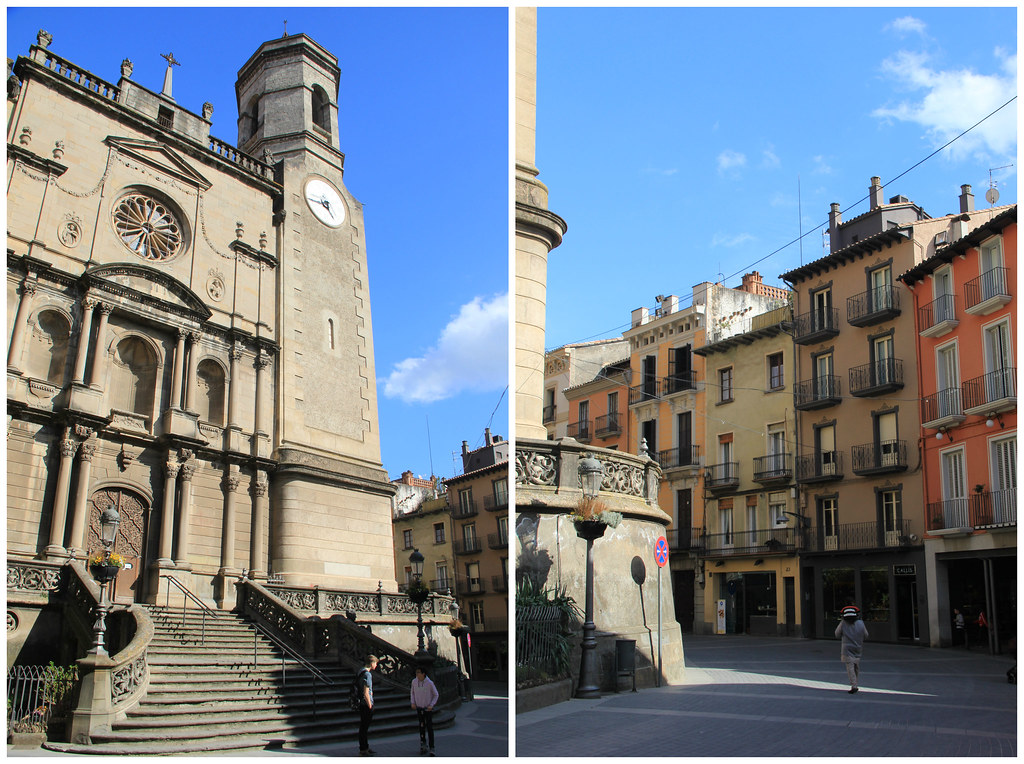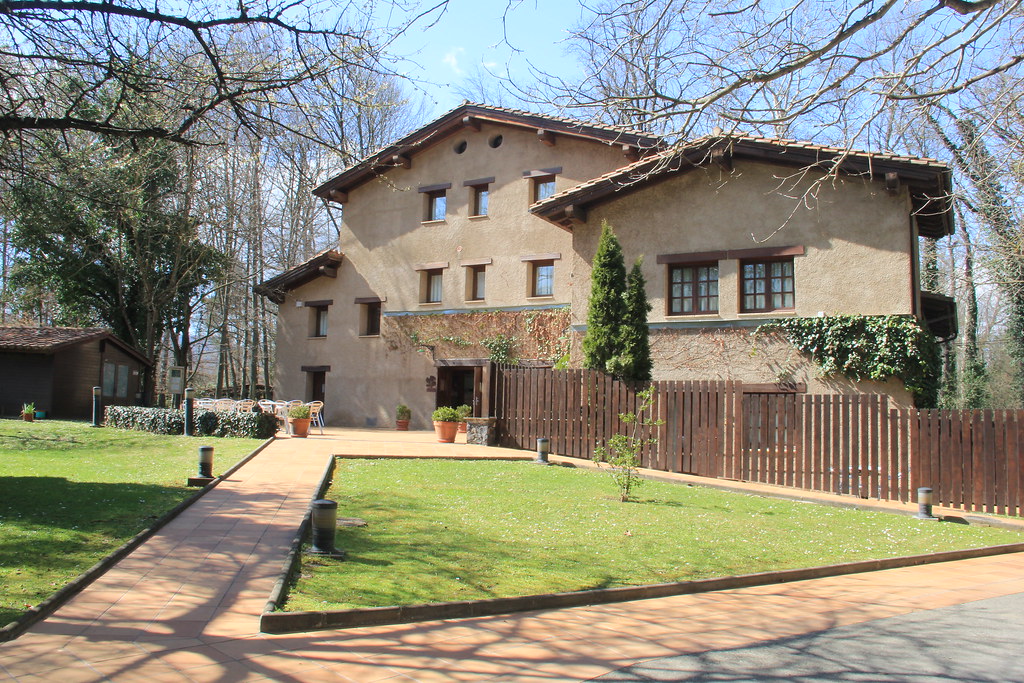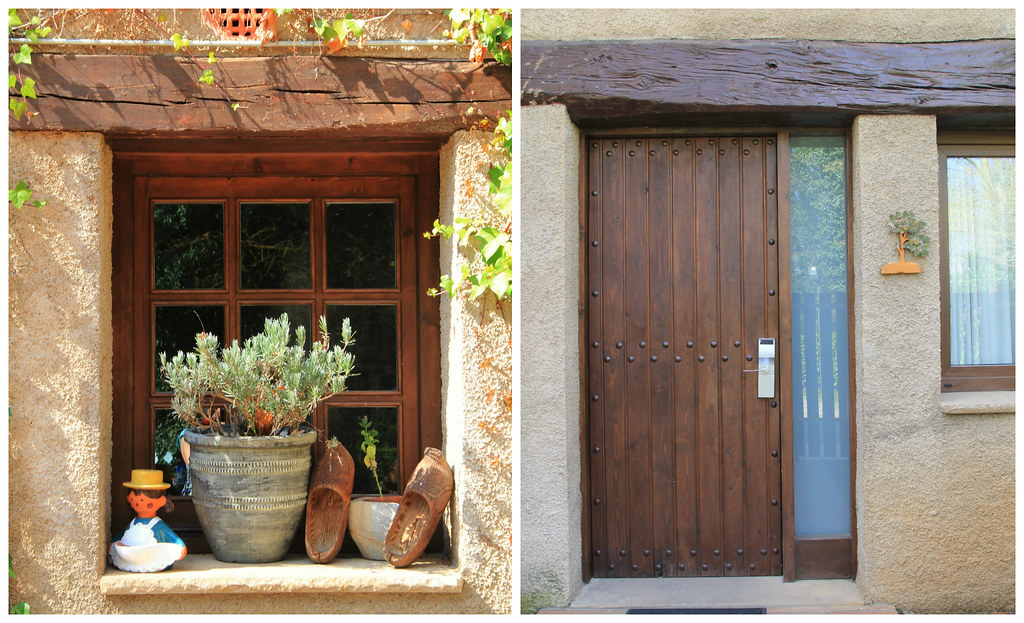Olot was the starting point of my three-day hiking adventure through Catalonia. Located approximately 50 kilometres northwest of Girona, in the midst of the Pyrenean foothills and at the heart of La Garrotxa Volcanic Zone Natural Park, Olot makes a great base from which to explore the volcanoes of La Garrotxa, as well as being a historic, culturally interesting city in its own right.
When I arrived into Olot, just after lunchtime on a Wednesday afternoon in March, the sun was shining, the sky was blue, and the temperatures definitely didn’t require those jeans and that merino wool t-shirt I was wearing.
To put this in context, Olot is located in a fertile plain surrounded by the mountain ranges of Valentí, Aiguanegra, the plateau of Batet, Marboleny and Sant Valentí de la Pinya, and crossed by the river Fluvià and the Riudaura stream. It’s recognised as being the wettest part of Catalonia.
In fact, popularly, it is said that:
“If it isn’t raining in Olot, it isn’t raining anywhere” (Si no plou a Olot, no plou enlloc in Catalan)
So, the fact that I’d arrived to sunshine and blue skies was a good omen.
Once I’d checked into my hotel on the outskirts of town, I had just a few hours to explore the city before starting my hike the following morning.
Some of the links in this post are affiliate links. All this means is that if you make a purchase through one of the links I have provided, I will earn a small commission as a result but the cost to you will remain exactly the same.
What is there to see and do in town?
Having also now visited Besalú, I can honestly say that Olot is ‘a lot’ (see what I did there? ;-)) less touristy. The fact that Besalú is touristy does in no way detract from its charm (especially since many of the tourists are day-trippers from Girona so the early mornings and late afternoons/evenings are still delightfully quiet), but if you want to visit a Spanish city that feels more authentically Spanish then Olot is definitely worth stopping by.
The nicest (and possibly oldest) part of the city is the area surrounding Plaça Mayor (Main Square) and the Romanesque Sant Esteve Parish Church, built in 1763. The church was closed when I stopped by but I had an enjoyable time wandering around photographing its exterior from various different angles (which is incredibly tricky when it’s such an imposing structure and is surrounded by narrow streets and tall buildings).
Good to know: The opening hours are Monday-Saturday 8am-noon, so get there early to avoid disappointment. Entry fee €3. However it’s also possible to organise guided tours at tresorparroquialsantesteve@gmail.com
Opposite the entrance to the church is this building which reminded me of the Pena Palace in Sintra, Portugal.
If you head away from the church down a side street adjacent to this unusual edifice, you’ll arrive in a long square in which you’ll find Casa Sola Morales, a beautiful building which was constructed in Baroque style in 1781 and subsequently given a Modernista-style restoration of its facade by architect Domènech i Montaner in 1915-1916.
Unfortunately there was a lot of construction work going on in this area when I visited, so I had to shoot this photo through the gaps in some metal fencing – more of which you can see in the bottom part of the photograph itself (there was literally no escaping it!)
Also on my list to visit (but unfortunately I ran out of time) were:
- Museu de la Garrotxa. Located in the former nursing home of Olot, this museum illustrates two facets of the local history and economy (wood industry, bell-making and textiles) and exhibits a collection of paintings and drawings by 19th and 20th century Catalan artists.
- Sanctuary of Santa Maria del Tura. Rebuilt by Barcelonean architect Francesc Mas in 1763, this old sanctuary still retains some of its original frescoes on the cupola.
- Convent of La Mare de Déu del Carme. Founded in the late 16th century, this convent is a Site of National Cultural interest and contains a beautiful Renaissance cloister (1603), which is one of only a handful of surviving cloisters of the Renaissance period in Catalonia.
The reason I ran out of time is because I wanted to make the climb to the Volcà del Montsacopa, one kilometre north of the centre of town.
Olot is known as “the city of volcanoes” because there are a total of four volcanoes within its city boundaries, the closest and most easily accessible being Volcà del Montsacopa.
The most straightforward route from the Sant Esteve Parish Church is to follow Passeig de l’Escultor Miquel Blay. This road then turns into Carrer Rosser, which then joins Carrer Pintor Domenge. However I chose to wander through the backstreets of the old city instead, stumbling upon some street art as I did so.
As you make the climb towards the volcano, don’t forget to look behind you or you’ll miss some stunning views back down on to the city of Olot.
I was shooting into the sun, so I had to do a bit of editing on this one!
You’ll know you’ve reached the approach to Volcà del Montsacopa when you see a series of brick-built chapels lining the right hand side of the pathway. These are the chapels of the Via Crucis (Stations of the Cross) and date from the 16th century. They were inaugurated in 1949, coinciding with the golden anniversary of Pope Pius VII’s vocation.
You’ll also find some round stone towers along the pathway, known as Sant Francesc Towers, which – along with the old city walls – played an important role in protecting Olot in the Third Carlist War (1872-1876).
It’s still possible to go inside theses towers, and climb their (unfortunately not original) spiral staircases up to a viewing platform at the top.
You can actually follow the pathway all around the circumference of Volcà del Montsacopa. It’s a lovely, tranquil walk with incredible views in every direction.
The volcano itself has not erupted for over 11,000 years (the last eruption of a volcano in Catalonia was Volcà de Croscat, approximately 11,500 years ago), so as you can imagine the land itself has been reclaimed by vegetation over time.
In fact, as I looked down into the crater (because the volcano has, quite literally, still left a very large dent in the landscape), I spotted some local children using it as a football pitch, complete with makeshift goalposts at either end.
Volcà del Montsacopa is unique in the Natural Park of the Volcanic Area of La Garrotxa, as it has retained its circular structure and has been left undamaged by post-erruptive lava flows. It has a diameter of 120 metres and is 12 metres deep.
Fun fact: For those of you who don’t speak Spanish, “copa” (in Montsacopa) means “glass” (as in a wine glass, with a bowl-like shape, rather than a tumbler, which is a “vaso”), indicating the shape of the crater.
On the far side of the crater you can see the Capilla de Sant Francesc (Sant Francesc Chapel). Built in 1817, it has a single nave and a bell tower, as well as accommodation for tenants. It is from here that you’ll get the best views of the city down below, and of the Fluvià river, the Bisaroques and Montolivet volcanoes, and the ranges and valleys which surround Olot.
The Extinct Volcanoes of La Garrotxa
There are approximately forty extinct volcanoes to be found inside the Garrotxa Natural Park, so if you’re not content with visiting the four within Olot’s city boundaries, it’s possible to hike to many (if not all of) the other volcanoes of La Garrotxa.
I visited both Santa Margarida Volcano and Volcà de Croscat on a circular route from Olot. It was a 20.7 kilometre hike that took me between 6 and 7 hours with stops and including retracing my steps for around two kilometres because I got lost.
I would totally recommend doing some hiking in the area if you can, as much for the journey and the beautiful vistas you pass along the way as the destination itself. You can read about the hike I did here.
There’s a visitor centre at Fageda d’en Jorda (inside the park) where the staff should be able to help you with maps and suggested routes. On the whole I found the routes to be very well signposted and there were plenty of other people using the trails (although they were by no means overcrowded).
Getting to Olot
Various budget airlines run regular flights from the UK to Girona, and from there it’s just a 60-minute direct bus journey to get to Olot. It is possible to take the indirect route via Banyoles as well, if you’re feeling adventurous. Timetables are available at http://www.teisa-bus.com.
Where to stay in Olot
If you’re visiting the area to do some hiking to the volcanoes of La Garrotxa then I’d recommend staying close to the hiking trails, rather than in the centre of town. I stayed at Mas Can Blanc, a small hotel that’s situated in a beautiful location in the Garrotxa Volcanic Zone Nature Reserve, surrounded by trees and birdlife. Although the staff don’t speak a ton of English, they are friendly and hospitable, and serve up a wonderful traditional Spanish breakfast every morning (think breads, olive oil, garlic, tomatoes, chorizo-type meats, cheeses and Spanish omelette, as well as a selection of cakes and pastries).
There’s a lovely sun terrace, swimming pool (although it wasn’t open when I stayed; presumably too early in the season), and on-site parking, as well as bicycle hire.
Having looked at the alternatives in the centre of town (of which this is probably the most central), I also think you get much better quality accommodation by staying a little farther out.
Another great option is to rent your own little apartment for the duration of your stay. This one looks lovely and is right next door to a Lidl, where you can stock up on groceries with which to whip up your very own little Catalan feast.
Get up to £50 off your first Airbnb booking by registering via this link.
Where to eat in Olot
If you’re self-catering or you need to gather some snacks and drinks for your hike, there’s a supermarket in the centre of town (its location is shown on the map below).
Alternatively if you choose to stay at Mas Can Blanc, there’s a couple of restaurants within about 50 metres of the property – La Deu and Font Moxina. I ate at La Deu and can thoroughly recommend it. The food was very good and the staff were both friendly and attentive. €15 will buy you three courses, a small bottle of water and a quarter of a bottle of wine (so, one glass basically).
I ordered a lovely combination of a salad with feta and autumn fruits (pictured), bacalao with a creamy sauce and créme caramel (my favourite dessert; sometimes seen on the menu in Spain as “flan” or “crema Catalana”)
If you like this article, please share it on social media using the share buttons at the top of the post. Alternatively you can follow along on Facebook, Twitter, or Google+ or you can look me up on Instagram or Pinterest too!
And here are some pretty images for your Pinterest boards 😉





























5 Comments
This is such an underestimated area of Spain. Your pictures truly capture the essence. Beautiful!
It really is, Pascale! I fall a little bit more in love with Spain every time I return to find more places like this one 🙂
Such a detailed guide, thanks for sharing! And I love your photos, it looks like such a cute little town, I’ll have to add it to the bucket list!
I love the colourful buildings and what a good omen you arrived on such a perfect day. Cool slideshows, by the way.
I only was a few hours in Olot. I came from Girona via the ‘via Verde’ with the bike, and I thought maybe to return this year.
Your blog convinced me to act! Olot, here we come.
Thanks for your detailed comments on this beautiful place!